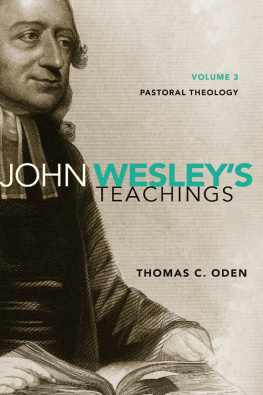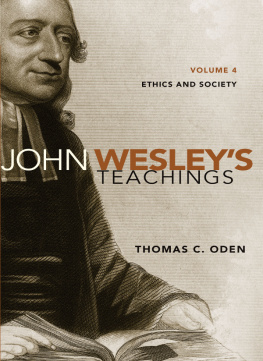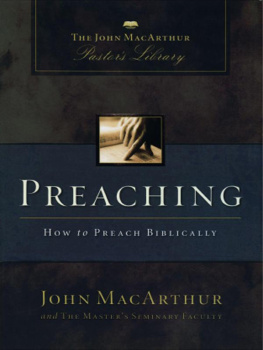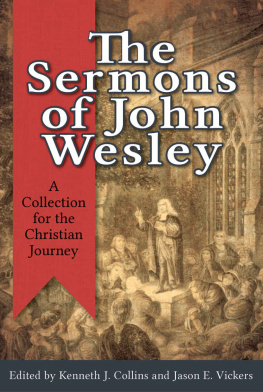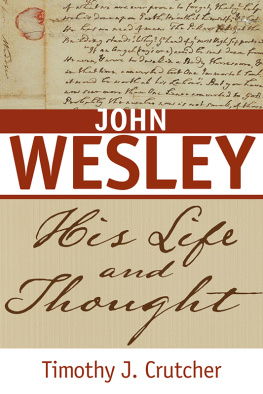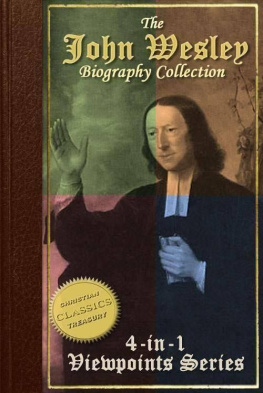John Wesleys Standard Sermons
An Annotated Summary
John S. Knox
Foreword by Phil Towne
Afterword by David R. Leonard
John Wesleys 52 Standard Sermons
An Annotated Summary
Copyright 2017 John S. Knox. All rights reserved. Except for brief quotations in critical publications or reviews, no part of this book may be reproduced in any manner without prior written permission from the publisher. Write: Permissions, Wipf and Stock Publishers, 199 W. 8th Ave., Suite 3, Eugene, OR 97401.
Wipf & Stock
An Imprint of Wipf and Stock Publishers
W. th Ave., Suite
Eugene, OR 97401
www.wipfandstock.com
paperback isbn: 978-1-5326-0809-4
hardcover isbn: 978-1-5326-0811-7
ebook isbn: 978-1-5326-0810-0
Manufactured in the U.S.A. April 17, 2017
Table of Contents
This book is dedicated to my beloved students.
It is comforting not to be alone, surrounded by friends,
as we explore the deep ways of God together.
I want to know one thing, the way to heaven
how to land safe on that happy shore.
God himself has condescended to teach the way:
for this very end he came from heaven.
He hath written it down in a book. O give me that book!
... Let me be homo unius libri [a man of one book].
Here then I am, far from the busy ways of men.
I sit down alone: only God is here.
In his presence I open, I read his Book;
for this end, to find the way to heaven.
John Wesley
. Bartleby.com, A Man of One Book.
Foreword
A t most seminaries, there are not many pastors as renown and celebrated as Rev. John Wesley, the founder of the Methodist movement ( 1703 1791 ). I remember first studying Wesley when I was in graduate school in Portland, Oregon. I had, of course, heard of the man prior to that, but when learning of his open-air preaching and his powerful method of small groups, I was instantly impressed and captivated by his character. After more serious reading and reflection on his standard sermons, I found them to be inspiring and refreshing, and still relevant today, somewhat surprisingly.
History tells us that Wesley viewed the entire world as his parish. It did not matter where he was at, geographically; rather, he believed that he was called to share the Good News whenever he was called. As a counter-point to the Calvinist perspective of his day, he was also a staunch Arminian, which comes out clearly in the sermons provided in this book. God lets people make choices, and Wesley felt called to help them make good, holy ones.
Wesleys own personal story is an interesting onealthough a well-trained and well established Christian pastor, when attending a Moravian meeting in 1738 , he experienced a turning point of his own that left his heart feeling strangely warmed in a way that allowed him to have full assurance of his own forgiveness of sins and salvation. It was soon after this epiphany that his sincere evangelism began with English Anglican George Whitefield and Wesleys brother, Charles, in collaboration and support.
Spiritual brothers in the Holy Club, which spread to the American colonies in the 1730 s 1740 s. Their skills and gifts were well accepted by most who had the fortunate opportunity to hear them preach on salvation and sanctification. John Wesley, himself, was down-to-earth when speaking to the crowds, which contrasted greatly with the reserved and aloof high church approach held by most church leaders in his day. Wesleys style of ministry was driven by a theological perspective suggesting that salvation was for all peoplenot just a select few or the social elites. For Wesley, love multiplied, but hate divided.
Perhaps driving his generous spirituality, Wesley placed a very high (if not the highest) value on the Bible. Thus, you will find in his sermons a rich exposition of scripture, as well as a high authority placed on the Holy Bible for guiding society and morality, and for aiding in understanding the complicated (and sometimes corrupt) culture of his day. Wesleys sermons are not simple, but they are sublime.
With the aforementioned in mind, Dr. John S. Knoxs John Wesleys Standard Sermons: An Annotated Summary offers valuable guidance for pastors, scholars, and laypeople who might be teaching through some of the same scriptural passages that Wesley analyzes, or studying Wesleys sermons for inspiration in their own pastoral messages, or for others who simply want to immerse themselves in Wesleyan thought and philosophy. The summaries of sermons contained in Knoxs book come from Wesleys best homilieseach one poignant and purposeful for promoting personal growth and inspiration. Perhaps like Wesley, readers will feel strangely warmed through the reading of these beautiful, heart-felt words imploring us to draw nearer to God, to each other, to holiness, and to love.
Wesley played a crucial role in English and American church history, and pastors and theologians from all denominations are indebted to him for his amazing preaching and his provocative teachings. John S. Knox has done a service for pastor and parishioner alike by writing this helpful summary of Wesleys worksnot just to intellectually unravel and understand the sermons of Wesley, but to also encourage readers to apply the great truths concerning the heart of God presented in scripture.
I pray a blessing for all readers as you read and use John Wesleys Standard Sermons: An Annotated Summary .
Phil Towne
PhD, Fuller Theological Seminary
Director of SALT and Certificate Programs
Assistant Professor of Bible and Ministry
Hope International University
. Olsen, The Story of Christian Theology , .
. Olsen, .
. Gonzalez, Wesley, John ( 1703 ), 1483 .
. Olsen, .
Preface
T he beginnings of this book began nearly two decades ago ( 2001 ) at George Fox Seminary in an independent study course that I took on John Wesley, the father of the Methodist Movement. Having grown up in both Southern Baptist and Conservative Baptist churches, my understanding of Wesley, Arminianism, and Methodism was limited, to say the least, but having learned more about the man and his mission in my Christian History and Thought class, I felt my own heart yearning to understand more about Wesley (in fact, I would later write my Masters thesis on Jacobus Arminius and his Declaration of Sentiments , which helped me appreciate Wesleys 1765 article, What is an Arminian?). Thus, I began my study, reading all the primary and secondary works that I could get my hands on regarding this prestigious founder of that monumental movement in those few months.
My professor, Dr. Larry Shelton, had prescribed several important books for my proper Wesleyan edification including Christianity According to the Wesleys: The Harris Franklin Rall Lectures, 1954 b y Franz Hildebrandt (Baker, 1996 ), Aldersgate Heritage (Methodist Evangelistic Materials, 1964 ), Scriptural Christianity: A Call to John Wesleys Disciples b y Robert Chiles (Francis Asbury, 1989 ), John Wesley and Education b y Alfred Body (Epworth Press, 1936 ), Wesleys A Plain Account of Christian Perfection (Beacon Hill, 1966 ), and Wesleys Standard Sermons: as He Approved Them (Schmul, ), of course. I provided book reviews of the secondary sources and a reflection paper on A Plain Account of Christian Perfection (I find both primary and secondary works to be quite edifying; however, I always have enjoyed reading the source and coming up with my own conclusions). Additionally, I also presented my beloved professor an annotated summary of each of Wesleys sermons.


